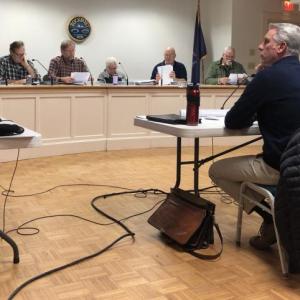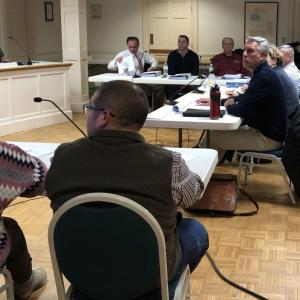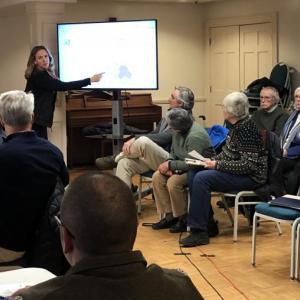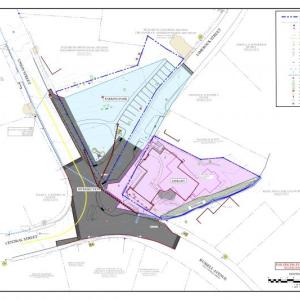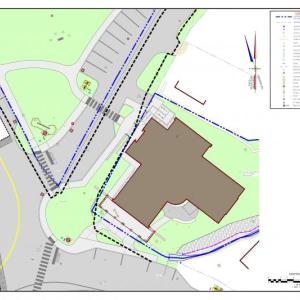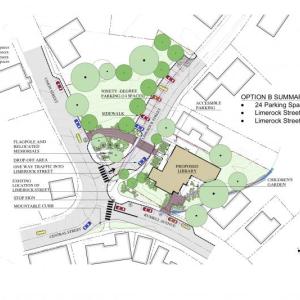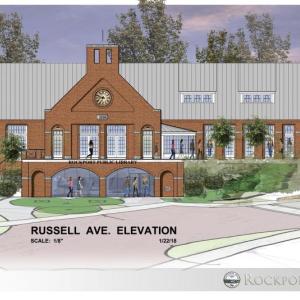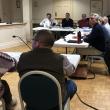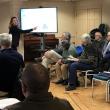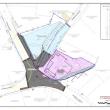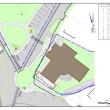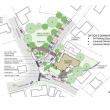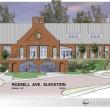Facing budgetary pain, Rockport deliberates over parking for new library
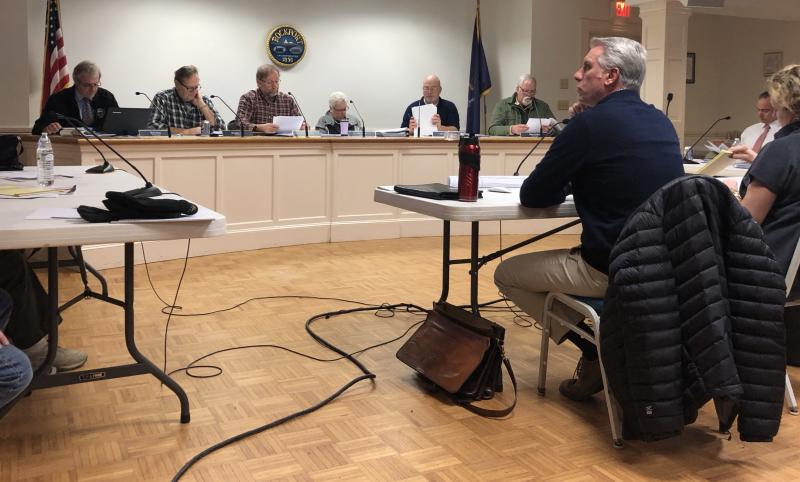 Rockport’s Select Board met with the town’s Budget Committee, as well as engineer Will Gartley and Rockport’s representatives of the new library construction project Feb. 26 at the Rockport Opera House. At the podium: Town Manager Rick Bates, Rockport Select Board member Doug Cole, Chairman Ken McKinley, and members Deb Hall, Jeff Hamilton and Mark Kelley. (Photo by Lynda Clancy)
Rockport’s Select Board met with the town’s Budget Committee, as well as engineer Will Gartley and Rockport’s representatives of the new library construction project Feb. 26 at the Rockport Opera House. At the podium: Town Manager Rick Bates, Rockport Select Board member Doug Cole, Chairman Ken McKinley, and members Deb Hall, Jeff Hamilton and Mark Kelley. (Photo by Lynda Clancy)
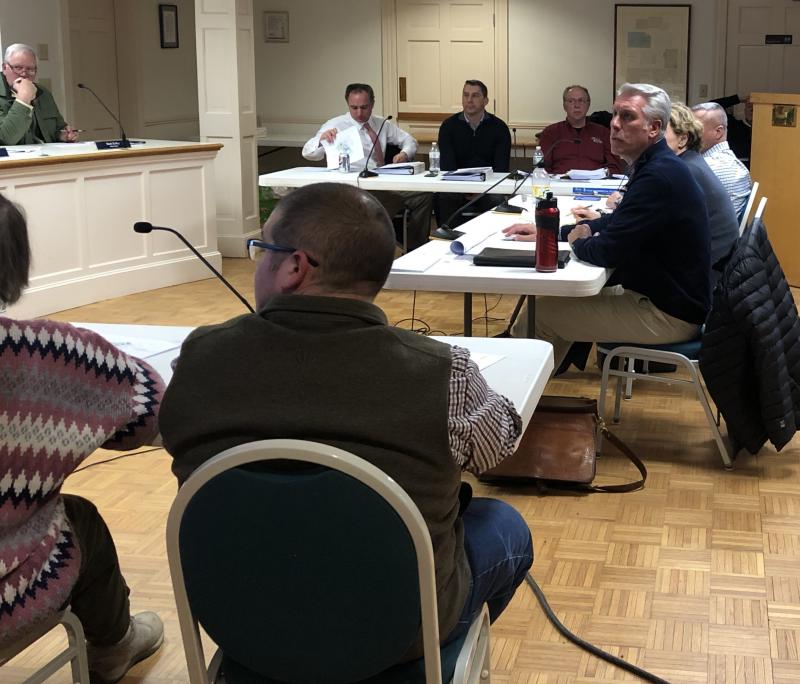
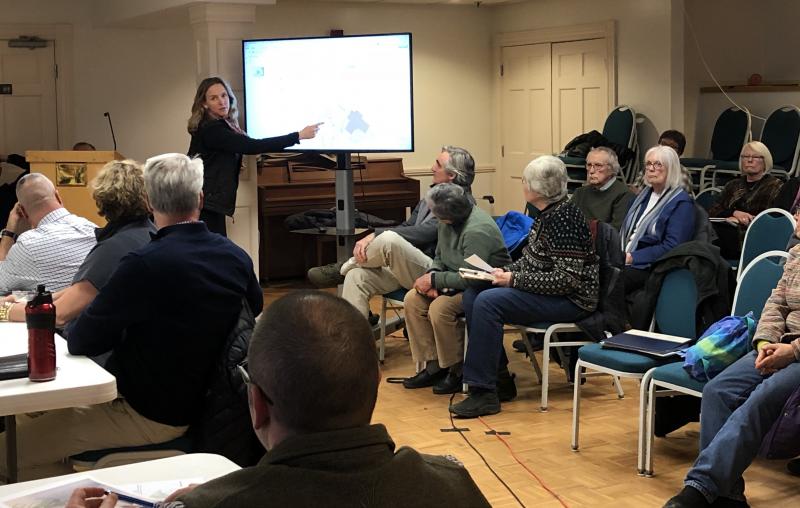 Rockport resident Jen Porter asks questions about the parking plans on Limerock Street in Rockport Village at a meeting of the town’s select board and budget committee, as well as interested citizens. (Photo by Lynda Clancy)
Rockport resident Jen Porter asks questions about the parking plans on Limerock Street in Rockport Village at a meeting of the town’s select board and budget committee, as well as interested citizens. (Photo by Lynda Clancy)
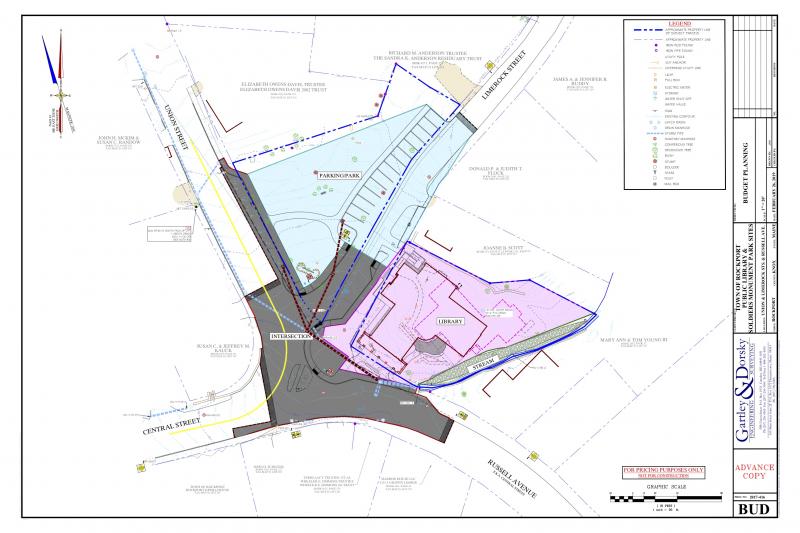 The current site map that shows the different sections of the project and funding prospects. The gray represents the intersection that is to be rebuilt with a combination of state funds ($110,000); tax increment financing funds held by the town and taxpayer dollars. The blue line shows the existing edge of Limerock Street and how the rebuilt Limerock Street will edge further into the park on its south corner.
The current site map that shows the different sections of the project and funding prospects. The gray represents the intersection that is to be rebuilt with a combination of state funds ($110,000); tax increment financing funds held by the town and taxpayer dollars. The blue line shows the existing edge of Limerock Street and how the rebuilt Limerock Street will edge further into the park on its south corner.
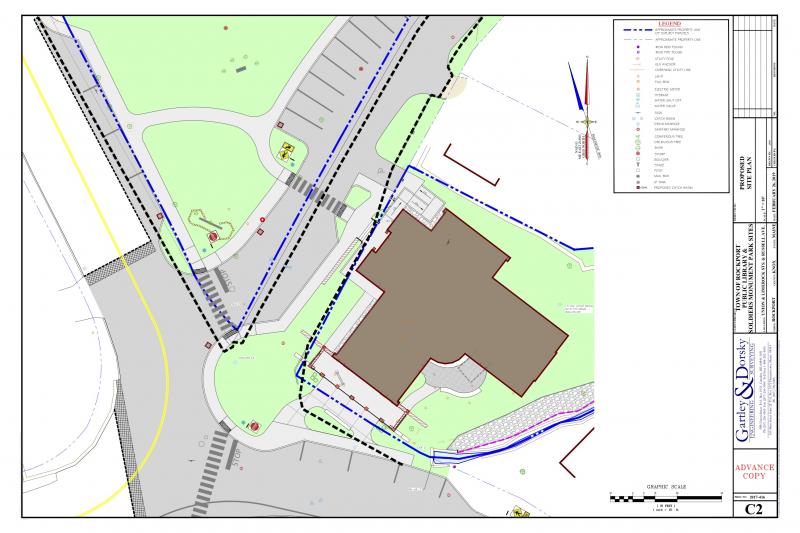 The proposed site plan, in simple delineation.
The proposed site plan, in simple delineation.
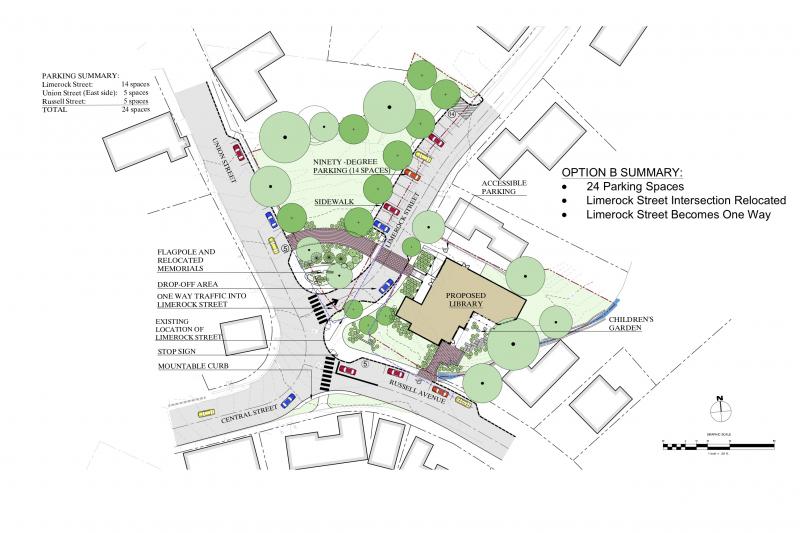 In 2016, architect Dick Reed drew this plan for a new library that also proposed the rebuild of the intersection at Limerock, Union and Central streets, with Russell Ave.
In 2016, architect Dick Reed drew this plan for a new library that also proposed the rebuild of the intersection at Limerock, Union and Central streets, with Russell Ave.
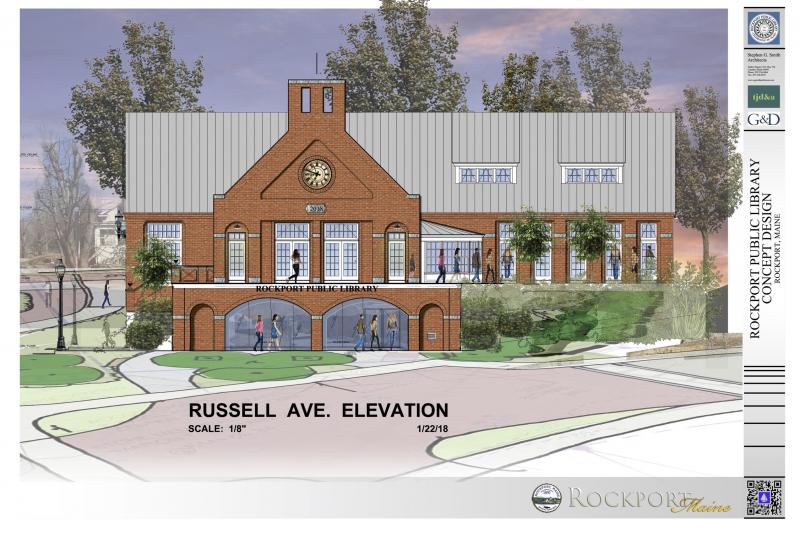
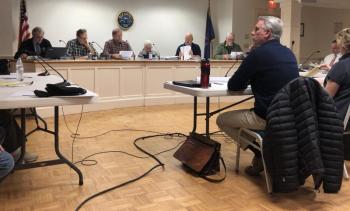 Rockport’s Select Board met with the town’s Budget Committee, as well as engineer Will Gartley and Rockport’s representatives of the new library construction project Feb. 26 at the Rockport Opera House. At the podium: Town Manager Rick Bates, Rockport Select Board member Doug Cole, Chairman Ken McKinley, and members Deb Hall, Jeff Hamilton and Mark Kelley. (Photo by Lynda Clancy)
Rockport’s Select Board met with the town’s Budget Committee, as well as engineer Will Gartley and Rockport’s representatives of the new library construction project Feb. 26 at the Rockport Opera House. At the podium: Town Manager Rick Bates, Rockport Select Board member Doug Cole, Chairman Ken McKinley, and members Deb Hall, Jeff Hamilton and Mark Kelley. (Photo by Lynda Clancy)
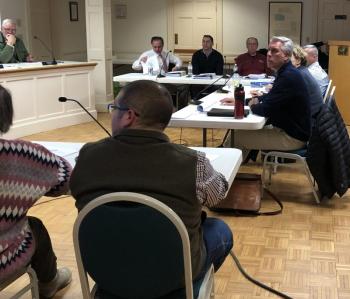
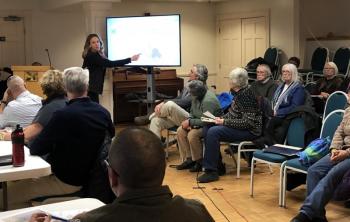 Rockport resident Jen Porter asks questions about the parking plans on Limerock Street in Rockport Village at a meeting of the town’s select board and budget committee, as well as interested citizens. (Photo by Lynda Clancy)
Rockport resident Jen Porter asks questions about the parking plans on Limerock Street in Rockport Village at a meeting of the town’s select board and budget committee, as well as interested citizens. (Photo by Lynda Clancy)
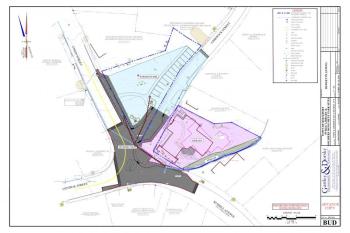 The current site map that shows the different sections of the project and funding prospects. The gray represents the intersection that is to be rebuilt with a combination of state funds ($110,000); tax increment financing funds held by the town and taxpayer dollars. The blue line shows the existing edge of Limerock Street and how the rebuilt Limerock Street will edge further into the park on its south corner.
The current site map that shows the different sections of the project and funding prospects. The gray represents the intersection that is to be rebuilt with a combination of state funds ($110,000); tax increment financing funds held by the town and taxpayer dollars. The blue line shows the existing edge of Limerock Street and how the rebuilt Limerock Street will edge further into the park on its south corner.
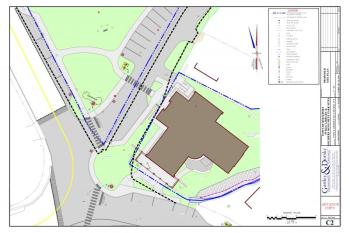 The proposed site plan, in simple delineation.
The proposed site plan, in simple delineation.
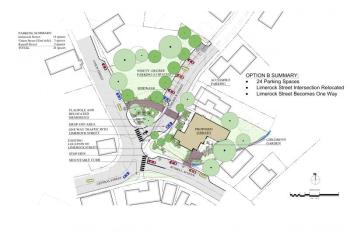 In 2016, architect Dick Reed drew this plan for a new library that also proposed the rebuild of the intersection at Limerock, Union and Central streets, with Russell Ave.
In 2016, architect Dick Reed drew this plan for a new library that also proposed the rebuild of the intersection at Limerock, Union and Central streets, with Russell Ave.
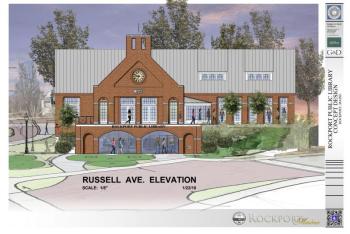
ROCKPORT — A piece of the new library project in Rockport is at the root of current fiscal debate amongst the town’s select board, budget committee and some citizens, as a municipal budget for 2019-2020 takes shape. The work is especially arduous this year as the town contends with cutting $719,000 from a proposed budget while investing in the new library infrastructure, and ensuring the townwide infrastructure if roads does not fall into disrepair.
(The Select Board is scheduled to convene at 5:30 p.m., Monday, March 4, in the Geoffrey C. Parker Meeting Room at the Rockport Opera House, to continue discussing the issue. There is no agenda for this workshop.)
A Feb. 26 municipal workshop of the Rockport Select Board and Budget Committee reflected varying opinions on how to keep the library construction on track without disproportionately spending money on the project at the expense of the rest of the town.
At the workshop, citizens and some board members also questioned the substance of the building project as it affects Memorial Park, across the street from the library site, and the proposed plan to create 14 parking space there.
Some citizens took umbrage with the board for not involving the town’s Parks Committee with the parking space design, which will require cutting approximately 6,500 square feet into the lawn and downing trees.

On Nov. 6, 2018, Rockport voters approved a $1.5 million bond to help fund the construction of a new, $3.5 million library building at the town’s Limerock Street site.
A fundraising group, organized as the Rockport Library Foundation, is presently soliciting $2 million or more in private donations to help build the new 7,000-square-foot structure on the corner of Russell Ave., and Limerock, Union and Central streets.
Construction of parking spaces for the facility is expected to take place along the Limerock Street side of Memorial Park.
Money for the parking space creation in Memorial Park and the reconfiguration of the village intersection has not been considered part of the bond spending nor the Foundation fundraising goal.
“I have sympathy, but not a lot,” said Rockport resident and former Select Board member Sani Fogel, commenting toward the end of a two-hour workshop held in the Geoffrey C. Parker Meeting Room. “None of the park discussion had come to [the Parks] committee until last week. Most trees will come down. We never saw plans in detail, and it was never discussed with us. It’s appalling that no one is speaking for the park. It is, by the way, a Memorial Park. The town turned it into a memorial park. Be very careful about dividing this park up.”
And, she finished, “You don’t need these 14 spaces.”
As it now stands, pragmatic solutions remain under discussion to complete the library project, as planned. The next meeting of the Select Board and Budget Committee is March 5 for a budget consensus meeting.
Fiscal solutions including structuring a cash flow schedule over two years instead of one and spreading out the payments for the different project pieces.
The town’s representative with the library project, Phi Builders & Architects (represented by Charlie Frattini and Bettina Doulton), are to return before the Select Board and Budget Committee with a cash flow schedule, broken in quarters, and spread over 2020-2021 to determine if it is possible to space out the $370,000 expenditure.
14 parking places, the park and an intersection
At issue is the town’s current proposed budget, as presented by Town Manager Rick Bates, and which includes a $370,000 expenditure for creating 14 new parking spaces and the reconstruction of an intersection where four streets come together — Central, Union and Limerock streets, plus Russell Avenue — in Rockport Village, at the site of the old library, now torn down. This plan includes shifting a portion of Limerock Street over into the park, as well, so as to accommodate new library footprint, which itself is to spread into the existing Limerock Street for the creation of a sidewalk and a drop-off area. (See diagrams).
Since the iteration of the library drawings, the first edition completed by architect Dick Reed in 2016, show the intersection as reconfigured to eliminate the center island. That plan included construction of 24 parking places.

At the Feb. 26 workshop, library project engineer Will Gartley, of Gartley and Dorsky, as well as Frattini and Doulton, explained to the Select Board and Budget Committee the current site plan, and work involved.
With the help of a map (see diagram), Gartley described the four sections of the new library project:

1) The narrow but necessary rebuild of the retaining wall and channel on the south side of the library parcel. It consists of riprap and rock, and the channel gets clogged. The work there is to rebuild the wall. Funding for that already exists in the 2018-2019 budget.
2) The intersection plans include reconfiguring Union Street and cutting into the park to create better parallel parking there, in addition to creating the bulb in front of the new library, and regrading Limerock Street.
It is, said Gartley, similar to the Reed 2016 plan, and the current design team is working with Terrance DeWan to finalize landscaping, “so there’s more to come with landscaping,” he said.
The architectural plans for the new library do not work without making changes to Limerock Street, he said.
While the Maine Dept. of Transportation anticipates contributing $110,000 for the intersection rebuild through its Municipal Partnership Initiative Program, and the budget calls for using $40,000 already tucked away in a tax increment financing district (TIF) fund for downtown parking and pedestrian improvements, the parking and intersection construction and reconstruction still calls for $220,000 of taxpayer spending and the expenditure is include in the proposed budget.
Gartley said he anticipated a formal acceptance of the project by the DOT in a month and that money would come in fiscal year 2020.
3) The portion of the plan in light blue represents the creation of 14 parking spaces along Limerock Street, and changes to the contour and grades that need to be made “to make this all work,” said Gartley. The associated cost of this portion of the project is $150,000.
Frattini said at the Feb. 26 workshop that Gartley had conducted a peer review of the project with Gorrill Palmer Consulting Engineers in South Portland and, “they have been supportive of this and believe it is the best solution for safety.”
Gartley said two or three DOT representatives reviewed the plan, as well.
He said later in the meeting that parts of Limerock Street must be regraded and the area of the 14 parking spaces needs to be refilled. It will be tight, he said, but not as steep.
“This parking is easier to maneuver than going up and down the hill,” he said, which is the existing parallel parking along Limerock Street.
Parking need
Current Rockport Public Library Director Ben Blackmon reported at the workshop that he has been counting cars in the lot at the library’s temporary facility on Route 1.
In June 2018, at the highest peak, he said he counted 18 cars. The average count in June was 13.4 cars in the parking lot in a given hour. In July, that was 14.
Overall, in those months, the average number of cars on a daily basis parking at the library was 122.
“The numbers go down in winter,” he said. “Nine is the high average in winter [for hourly parking]”
He added that four to five employees are currently parking in the back of the library.
When asked whether the 14 proposed parking places would be sufficient for growth, Blackmon responded, “I hope so.”
Gartley added: “I think this is a compromise. We have been hearing a lot of different things. Nobody wants to fill the park with parking.”
Rockport Select Board member Doug Cole asked for clarification as to when the parking component got blended with the intersection project.
Deb Hall, another select board member, said that was: “one of the questions from the other night. My question is: can we put certain projects into a different fiscal year so we don't deplete road work elsewhere in town?”
Frattini responded: “there are some portions that can be done in 2021. The great portion is to be done this year.”
Then he mentioned framing a schedule for invoicing and cash flow before the conversation turned back to employee parking.
“I don’t instruct on where my people are to park,” said Blackmon. “I’m not going to dictate where a person is to park,” explaining that when it is rainy and cold, employees might park closer, or on a Wednesday night, when the library is open until 8 p.m. and it is dark outside.
He said that when the library was in the village, “we would park behind the Opera House.”
Town Manager Bates pointed out: “There are a huge number of parking spaces through the village. They are available.”
Budget Committee member Jeff Charland looped the discussion back to the timing of payments and splitting expenses between the upcoming annual budgets.
“If it is going [heading] to budget, how much for this fiscal year and next year,” he asked.
He was told numbers would get worked on and produced for next week, when the Budget Committee and Select Board next meets on March 4.
Hall asked about making Limerock a one-way street.
“You might have space on the other side but it is not as safe,” Gartley said. “It is not necessarily advantageous for making it one-way.”
Frattini advised maintaining the four pieces of the project in one bid package. The invitation to bid and associated packages are expected to circulate soon. The Rockport Library Committee meets March 1 at 3 p.m. to talk about the bid packages.
“Four pieces can be bid [but] you can risk a higher number and more contractors,” he said.
For the sake of efficiency, he advised against parsing out the project. Gartley agreed, saying Limerock would be wiped out before construction and blasting and regrading would be taking place.
Back to the budget
Select board member Hall said the proposed budget takes away $285,000 from public works: “for doing paving in this town and gives all of the funds to the library project. it concerns some of us. We need to balance this. It can’t all go into the library but you have to help us figure out how to decide. We have roads that need to be fixed or we may lose them.”
Budget concerns
The Select Board and Budget Committee had been told by Bates that in order for the town to meet an LD 1 tax cap, $719,000 needed to be cut from the budget.
They already had spent hours poring over the 2019-2020 municipal budget, and meeting with department heads, but at a Feb. 20 workshop, the discussion took a heated turn when some members questioned the justification for budgeting $370,000 for the rebuild and parking when $235,000 was being eliminated from the public works portion of the budget.
That’s when Select Board Chairman Ken McKinley scheduled the Feb. 26 workshop of the board and committee, along with Gartley and Dorsky Engineer Will Gartley, Frattini and Doulton.
Click here to read the entire proposed 2019-2020 municipal budget.
LD 1, or the “tax cap” is a state law that requires municipalities to ask voters if they approve exceeding a formula driven tax cap. The law was enacted in 2005, after Maine determined, in 2002, that it had the second highest state and local tax burden in the nation. LD 1 was enacted to help limit municipal spending so as to not overburden taxpayers, unless those taxpayers agreed to exceed the limit.
Consequently, every year since 2005, municipalities are cognizant of the LD 1 spending cap and many try to hover around the LD 1 number, as formulated in a given year for any Maine town or city.
Complicating the issue is that Rockport’s valuation has decreased from $1 billion to $900 million (the result of dissolving a waterfront subdivision and reconfiguring it as one parcel), meaning less taxable value overall.
Other factors weighing on the Select Board’s collective mind this year is the increase in school spending, the result of borrowing heavily to build a new $32 million Camden-Rockport middle school in Camden.
She noted that it costs $150,000 to maintain one mile of a road and $233,000 to rebuild that same distance.
“Bettina will go back and break down quarterly costs,” said Frattini.
Doulton asked, “to push into fiscal year 2021?”
“Yes,” said Hall. “Sure we can raise taxes, but is that what our taxpayers want us to do?”
The library is scheduled to open in August 2020, and construction bid documents are to circulate in two to three weeks.
When asked whether there was a possibility of conducting more value engineering Frattini replied that he and Doulton were: “doing our due diligence in creating up-to-date estimates in drawings, the bid documents. We will be looking at whether there is an opportunity for portion of the parking to be included in the building budget.”
Doulton expressed optimism that, as estimates are coming through, that, “we’re really in good shape with this thing.”
Gartley and Frattini emphasized again the importance of simultaneously completing all four parts of the project.
“You want to have the sidewalks done at the same time, with no abrupt ends,” Gartley said. “You don’t want to do some of them, wait, and start again in a few weeks. You don’t want to do that.”
Hall told Frattini to be be creative and push some costs into the next fiscal year, which will help get approval at annual town meeting, she hoped.
Frattini said he would be creative.
“It’s a team effort,” he said.
Public opinion
Ames Curtis lead off the public comment period and reminded the town that she had supported the library being sited at the former Rockport Elementary School parcel on West Street. She told the select board that costs associated with the library project had not been made transparent to taxpayers.
“A lot of people voted because they thought all of those costs were going to be part of donated and bonds,” she said.
“If you start moving funds, please be transparent,” she said. “[This] really leaves people questioning how much they can trust the select board and selected parties.”
Richard Anderson, whose property abuts Memorial Park, said: “I have the same reaction as Ames. You tell us you can’t build without spending another $370,000 more. I think that is being disingenuous.”
He said the library project will be costing taxpayers $1.87 million, not $1.5 million, as spelled out before voters when the bond was presented.
He also pointed out that, on average, three cars are parked at the library in a given hour and that 54 percent of time there are fewer than 10 cars on average.
Anderson has said he opposes the expenditure associated with the Limerock Street parking, calling it fiscally irresponsible.
John Priestley, who lives in Rockport and is a resident as well as an architect who had submitted his own library and parking plan proposals to the town, asked why the Select Board was in a “big hurry” to get the project completed when the town was paying $36,000 annually in rental fees for temporary housing on Route 1 and anticipated paying $100,000 annually to repay the $1.5 million bond.
“Servicing the bond is more,” he said. “What’s the big hurry? There’s no incentive to rush the project from a financial [perspective].”
He said his alternative parking scheme for the site, which the Parks Committee has seen it earlier in the week, was more appropriate for the park.
It would “save half a million dollars,” he said.
“What is alternative site plan,” asked Hall.
“I haven’t seen it,” said Gartley.
Doulton told the Select Board and Budget Committee that the more a project gets delayed, inflationary costs increase the price tag, by 8 to 12 percent.
That’s when Sani Fogel told the board and committee that the Parks Committee should have been, and should be, included into the design conversation of Memorial Park.
“I hope the Select Board will pay more attention to committees,” she said. “It’s very important to use your committees. They care about what you do.”
Former Library Committee member Betsy Elwin agreed, saying: “I didn’t realize parks hadn't been consulted. This is another opportunity for creative thinking.”
She advised making “a plan for the park and improvements to make it more enjoyable.”
Bill Freeman suggested creating diagonal parking for nine cars and avoid dedicating 40 percent of the park to parking. Save more of the green, he advised.
Liz Dailey advocated for better parking, and planning for a 21st Century library.
“Speaking as a grandmother, I need close accessibility when escorting my grandchildren, 4, 6, 7 and 9, over to the library to take advantage of some of the awesome programming,” she said, as she advocated for the current parking design. “I do hear the people who live close by, but for all the people of Rockport –West Rockport, Clam Cove, Simonton Corner — please maintain 14 spaces.”
Abutter Elizabeth Davis asked the Select Board to include her, as a property owner right next to Memorial Park, and for whom the lights of parked cars would shine right into her windows, in all future discussions about the parking, especially if changes are considered for the existing plan.
“That would go a long way to create good will with neighbors,” she said. “If there is going to be a major shift and change, I would ask to be included.”
“You are on our radar,” said Select Board member Doug Cole.
Reach Editorial Director Lynda Clancy at lyndaclancy@penbaypilot.com; 207-706-6657.
Event Date
Address
United States

